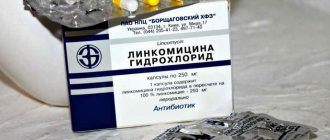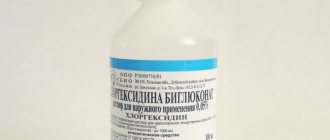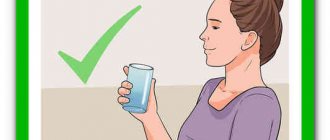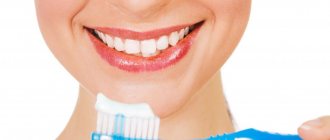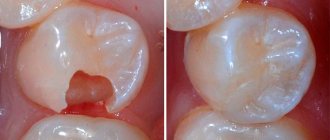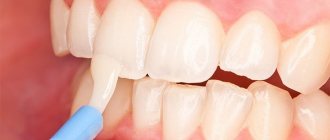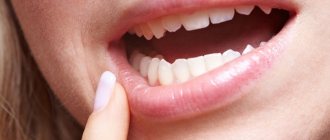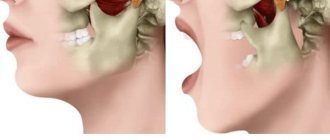Safe hygiene after tooth extraction - when and how can you clean the remaining ones?
Tooth extraction is performed surgically under anesthesia.
Extraction is the same operation as any other surgical intervention in the human body. Therefore, you need to be prepared not only for anesthesia and some temporary restrictions on food, but also for the rehabilitation period. To ensure that it is painless and does not cause negative consequences, the patient must adhere to all the advice and recommendations of the dentist regarding oral care before and after surgery. The first thing the doctor should pay the patient’s attention to after tooth extraction is how to properly brush the teeth and when to begin hygiene procedures. If this is done incorrectly, a person may feel discomfort and pain, and if not done in a timely manner, it can even cause serious complications. As a result, the entire gum healing process will be disrupted. An infection will begin to develop in the mouth, which can cause serious complications. So, the hole can become infected, which is extremely undesirable.
There, bacteria will begin to actively multiply, which will lead to serious intoxication of the entire body. This will lead to blood poisoning and other serious consequences. To prevent this, you need to pay more attention and time to caring for your teeth and oral cavity in the postoperative period.
Indications for use of the gastric lavage procedure
Gastric lavage - when to use this method:
- Food poisoning – a person has consumed stale food, after which he feels nausea, dizziness and abdominal pain;
- Excessive alcohol consumption - excess ethyl alcohol in the body leads to serious consequences, a person feels overwhelmed and weak;
- Drug intoxication - occurs when a person deliberately takes too much medication to die or when a child eats pills mistaking them for candy;
- Eating poisonous mushrooms is an extremely dangerous condition that can lead to death.
- Poisoning with chemicals , salicylates or methyl alcohol. It often occurs in young children who, due to their age, can drink acetone, detergent, or soap. Sometimes it was observed among drivers who use their mouths to pour gasoline into cans.
- Intestinal obstruction - the syndrome can occur with a chronic predisposition or when swallowing some physical body that can interfere with the usual evacuation of stool.
- Overeating – recently more and more cases of bulimia have been reported, when a person does not control how much he eats.
- Rotovirus , an infectious disease that causes diarrhea, vomiting and respiratory symptoms.
When to start hygiene procedures after extraction?
If a tooth, for example, was removed on the 9th, then it is recommended to fully brush the rest only on the 11th
The first day after tooth extraction, it is better not to touch the operated area at all, do not rinse your mouth, or brush your teeth, as this can not only cause pain, but also disrupt the healing process. Over the next few days, you need to be very careful with food, drinks, hygiene and other processes that disturb the resting state of the gums. For several days it is better not to touch the painful area at all, including with a brush.
Starting from the second day after tooth extraction, you can slowly begin to brush your teeth. This is done very carefully and gently so as not to injure the wound. During the postoperative period, it is not recommended to use various mouthwashes.
Gastric lavage solutions
The following solutions can be used to lavage the stomach:
- A solution of manganese has antiseptic and antimicrobial properties and is often used for rinsing. Throw a few crystals into prepared boiled water. It is important to strain the resulting liquid through gauze before use so that the remaining crystals do not enter the stomach.
- The saline solution is prepared as follows: add 1 tablespoon of salt to 1 liter of boiled water. Actively cleanses not only the stomach, but also the patient’s blood of toxins.
- Soda solution , you need to mix 2 tablespoons of soda and 5 liters of prepared water. Contraindicated for use in case of acid poisoning.
- The use of pharmaceutical sorbents is recommended to ensure that gastric lavage is most successful. They contain all the necessary components to neutralize the effects of poisons and detailed dilution instructions.
Algorithm of actions for returning home
There should not be any difficulties with maintaining oral hygiene after tooth extraction surgery. The main thing here is to follow all the recommendations and advice of the dentist. These include:
- Immediately upon arriving home, you need to remove the tampon from the wound, which the doctor will place there after extraction. If the bleeding continues to flow and does not stop, then you should make a new tampon, and then change it every 30 minutes until the bleeding stops. Swallowing blood is not recommended as it can become infected.
- In the first 24 hours after extraction, it is better not to use a brush, paste, floss or mouthwash. All these remedies will not help the natural healing process of the wound, but on the contrary, will lead to infection in it. A blood clot forms in the wound and cannot be washed out. If you do not allow this process to complete completely and disrupt its flow with a toothbrush or something else, then unwanted bacteria will get into the hole.
- A day after the procedure, you need to start rinsing your mouth with a solution of water and salt. This solution will help remove all bacteria and infection from the hole. To do this correctly, you need to put the salt mixture in your mouth, and then slowly tilt your head to the right and left. This will make it possible to carefully but efficiently clean the entire mucous membrane. There is no need to spit out the solution, but simply bend over the sink and allow the liquid to simply flow out.
- On the second day after tooth extraction, you can begin to gently brush your teeth, but do this slowly and carefully so as not to disturb the healed wound. It is best to purchase a brush with soft bristles and brush your teeth in a circular motion.
- If the healing process is normal, then on the third day you can use a regular brush.
Actions after the procedure - prevention
To minimize the intensity of dental plaque formation, proper care and prevention should be provided. To do this, experts recommend adhering to the following rules:
- use a brush whose degree of hardness corresponds to the condition of your enamel - it is better to consult a specialist on this matter,
- carry out standard cleaning daily - after waking up and before going to bed,
- You need to brush your teeth in a circular motion for at least 5 minutes,
- after eating, do not forget to floss, rinse your mouth to remove food debris after a meal,
- for better care, it is worth purchasing an irrigator - a portable device supplies a powerful stream of water and air under high pressure,
- do not forget about the back side of the rows, as well as the surface of the tongue, where a huge number of bacteria are concentrated,
- include hard vegetables and fruits in your diet - when biting, the enamel is cleansed of microbial plaque,
- eat less sweets, limit your consumption of sugary drinks, coffee and black tea. You also need to stop smoking.
To maintain hygiene, it is recommended to undergo a comprehensive cleaning twice a year. According to experts, this is the optimal frequency that will prevent the formation of too much deposits that can provoke the development of caries and other dental problems.
Features of hygiene after extraction “8-k”
The process of wisdom tooth removal and the recovery period after surgery are somewhat different from standard extraction.
If you do not follow the rules of oral hygiene in the postoperative period, an infection may enter the wound, which will lead to alveolar osteomyelitis. This is an inflammatory process that develops in 20% of cases after extraction of figure eights. To prevent this, you must strictly follow the doctor’s recommendations during the first week after surgery.
Read also: Is it painful to remove a tooth without a nerve?
Caring for the oral cavity and brushing your teeth after wisdom tooth removal is carried out according to the following algorithm recommended by practicing dentists:
- The bandage or gauze must be changed according to all doctor's recommendations. If blood continues to ooze from the wound, then the tampon is changed every 30-40 minutes. If the bleeding does not stop even after several hours, you should consult a dentist. During the first 1-2 days, a small amount of blood may be released from the wound, which does not exceed a few drops.
- You should not brush your teeth on the first day after surgery. In addition, you should not use floss or mouthwash for several days. If this rule is not followed, osteomyelitis may develop. When cleaning with a regular brush, a blood clot may fall out, which forms in the wound and does not allow bacteria to penetrate inside, or the integrity of the sutures at the operation site may be compromised.
- Cleaning the hole that forms after the removal of a wisdom tooth is strictly prohibited during the first 3 days. Instead of using a brush, you can rinse your mouth with a special saline solution. In a glass half filled with warm boiled water, you need to dissolve a pinch of ordinary table salt. Use the entire solution at once.
- A day after the extraction, you can begin to slowly brush your teeth. This should be done slowly and slowly, very carefully so as not to damage the clot and sutures. At first, it is advisable to avoid the painful area. To ensure that the process is painless, you need to use a brush with soft bristles.
- In the first days after extraction, it is better not to spit out the paste after brushing your teeth, as this may disturb the blood clot in the wound. Instead, you need to let it drain into the sink. Then rinse the mucous membrane with saline solution.
- When carrying out hygiene measures, we must not forget about cleaning the tongue, which also retains food particles, which can provoke the growth of bacteria.
When and with what can you rinse your mouth after surgery to remove the figure eight:
If you follow all the doctor's recommendations for keeping your mouth, teeth and tongue clean, then the risk of infection getting into the wound is very small.
What are some folk recipes for gargling a sore throat?
Here is another folk remedy for treating a throat
: You can dissolve a teaspoon of lemon juice in a glass of water. It will have an astringent effect on the mucous membrane. In addition, the acid will kill bacteria. A tablespoon of three percent hydrogen peroxide diluted in a glass of water has the same effect.
To soothe an irritated throat, you can gargle with the following mixture: take one teaspoon each of ginger powder and honey, dilute it in half a glass of hot water, add the juice of half a lemon.
At home, beetroot gargles for a sore throat are very effective. To do this, you need to grate the beets on a fine grater, squeeze out a glass of juice and add one tablespoon of vinegar. You should gargle with this solution five to six times a day.
How to alleviate the condition in the first days after surgery?
The postoperative period will pass quickly and painlessly if you follow all the rules of oral hygiene. A person should drink enough fluids and get plenty of rest. It is better to limit yourself to physical exercise and lifting heavy objects.
During the first days after surgery, you should eat soft and semi-liquid foods. For example, yogurt, porridge or puree. Such food will not irritate the mucous membrane, and its particles will not be able to get stuck in the interdental spaces.
In addition, heavy smokers need to limit themselves to this harmful habit for several days. Since smoking will interfere with the process of restoration and healing of the wound. This can also trigger the development of complications.
If a person has severe swelling after surgery, cold compresses applied to the cheek will help reduce it.
Finally, we offer practical advice from people who have already experienced tooth extraction.
After my wisdom tooth was removed, the surgeon strictly told me not to spit out the blood, as this would slow down the healing process of the wound. So I simply filled my mouth with water and slowly poured it over the sink. 4 days after the operation it became much easier.
Lyudmila, 24 years old
To ease the pain after a painful extraction and speed up the healing of the gums, I made a decoction of calendula and rinsed my mouth with it. Just let it cool to room temperature before use. It is better to check with your dentist before your appointment whether this solution can be used or not. But he helped me a lot.
Read also: After tooth extraction, bone protrudes in gum
Svetlana, 44 years old
After extraction, you should only eat soft foods and preferably chew on the other side of your mouth. This will help reduce the risk of inflammation and shorten the healing process.
Gregory, 36 years old
After removing one or more teeth, it is important to follow all the dentist's recommendations. This will help the wound heal properly and ensure a speedy recovery. In addition, it is very important to follow the rules of oral hygiene, namely brushing your teeth properly, rinsing your mouth with a saline solution, drinking a normal amount of fluid and not overloading yourself physically.
In the postoperative period, you should give preference to soft and light foods. And heavy smokers should give up their habit for a while.
Rules for gargling, how to gargle correctly
The throat is the body's first level of defense. The tonsils located in it are a reliable barrier to pathogenic microorganisms that accumulate on the mucous membranes. If microbes are not destroyed in time, they actively multiply and cause diseases. This is why rinsing is so important.
Treating the throat is not only an antiseptic measure, but also a sanitary and hygienic one. The rinsing procedure will help wash away viruses and pus that have accumulated on them from the tonsils. Surprisingly, not every patient knows how to do this correctly.
So, you should know that rinsing is recommended:
- 2 times a day (if the throat hurts moderately);
- every 4 hours (for severe inflammation).
In addition to rinsing, you can and should drink a lot of warm liquid: water, tea, juices.
When the tincture is ready, keep it covered for about 10 minutes. The throat remedy should be warm. The temperature of the solution is very easy to determine: dip your little finger into it. If after a few seconds your finger is not hot, the liquid is suitable for rinsing.
The medicinal tincture is taken into the mouth, kept for several minutes, and only then begin to rinse. They do this by raising their head up, blocking the path with their tongue. But usually this happens reflexively.
The duration of throat treatment with one sip is 20-30 seconds. There should be at least three similar sips per rinse.
After rinsing you should not:
- drink cold water;
- scream;
- There is;
- go outside (especially in winter).
It’s better to avoid walking altogether and stay warm.
To obtain maximum results, it is recommended to alternate solutions. Rinsing is carried out throughout the illness.
However, there is no need to be overzealous. This can lead to dry mouth and tonsils.
Is it possible to brush your teeth after tooth extraction?
After tooth extraction, it is extremely important to ensure proper oral hygiene in order to prevent inflammatory processes. However, contact of a hard brush with damaged, long-healing gum is extremely undesirable. However, experts do not prohibit such cleaning by waiting the required interval following the procedure. Today we will look at the main aspects affecting the possibility or impossibility of carrying out hygiene in this way.
Furacilin: mechanism of action
Furacilin (Furacilinum) is an antimicrobial drug for external or internal use, which has a pronounced antibacterial and antiseptic effect against almost all pathogenic microorganisms. Furacilin is available in several pharmaceutical forms: tablets, aqueous or alcoholic solution. The most popular is furatsilin in bright yellow tablets, which must be crushed and dissolved in water before use.
The active substance of furatsilin is nitrofural. Thanks to its antimicrobial and antiseptic properties, furatsilin not only actively copes with pathogenic bacteria, but also slows down and stops the growth of microbial flora. At the site of the inflammatory process, furatsilin comes into contact with the cell membrane, causing the death of the bacterium within 3 minutes. It is important to note that furatsilin solution for gargling will not give an immediate effect.
After gargling with furatsilin, the effect lasts for 40 minutes, so doctors recommend gargling at least every 1 to 2 hours. The effectiveness of rinsing with furatsilin is observed 3 to 4 days after regular procedures. Furacilin not only copes well with microbes, but also prevents their further reproduction and also stimulates the production of antibodies.
The drug Furacilin is reliable and bladeless, because it is often prescribed to children and pregnant women to treat a sore throat or various skin lesions.
Features of cleaning after tooth extraction
After the operation, an open wound forms in the place where the tooth once stood. Such circumstances indicate that when infection penetrates, massive inflammation will develop. If bacteria penetrate first into the soft tissues and then into the entire body, this is fraught with serious complications.
The task of the patient who has undergone such an operation is to ensure proper oral hygiene. It is necessary to maintain the correct microflora so that the gums heal and the wound heals. After some time, a blood clot forms in the area of the pulled out tooth, which prevents the penetration of microbes into the soft tissues.
To the question regarding whether it is allowed to use a brush on the damaged area, the answer is yes. However, you must follow the rules in everything:
- When you come home from the clinic, carefully remove the tampon covering the hole in the area of the missing tooth. The doctor placed this tampon, remove it. If bleeding is still coming out, make a new plug and apply it to the previous place. For this purpose, use a sterile cotton sponge or bandage. After installing the plug, bite down on it to ensure it snaps into place.
How to gargle
We figured out how to gargle correctly. Another question arises: what to rinse with? The fact is that there are many recipes for medicinal solutions. Each of them is good in its own way, because it helps relieve discomfort in the throat.
Perhaps the most popular recipe for a medicinal solution is a mixture of salt, soda and water. These components cope well with throat redness and pain. The products relieve inflammation and restore the vocal cords.
The remedies are taken in equal proportions, mixed thoroughly and used for their intended purpose, so there is always something to gargle with when there is pain.
Another useful recipe for a sore throat is propolis tincture. The substance is a natural product with antibacterial properties. For the solution you will need:
- 250 ml hot water;
- 5 drops of propolis.
Moreover, the solution is very useful as a prophylactic agent. It will help prevent laryngitis and similar diseases.
Essential oils, including tea tree, can help cope with the problem. This plant is characterized by a specific taste and smell. Despite this, the first signs of a cold and other pathologies of the upper respiratory tract will pass quickly.
Prepare the healing liquid in this way:
- kitchen salt (you can use soda);
- a glass of boiling water;
- tea tree oil (5 drops).
The peculiarity of oil is that it is not able to dissolve in liquid. But salt and soda do this without problems. Therefore, first a tablespoon of the product is saturated with plant oil, and then dissolved in water.
An excellent antiseptic is chamomile. It relieves sore throat. You will need to prepare:
- a glass of boiling water;
- a piece of gauze;
- 2 teaspoons chamomile.
The raw materials are poured with water, kept for 20 minutes, filtered through gauze. If the product cools down, warm it up a little in the microwave.
You can alternate rinsing with honey infusions. You will need to dilute May honey (a tablespoon) in a glass of water. The product is perfect for clearing a child's throat.
Care after wisdom tooth removal
The process affecting the features of care after the removal of eights is slightly different from that described above. If the manipulations are performed incorrectly, inflammation will develop; more than 20% of patients suffer from this. In order to prevent negative consequences, it is necessary to follow the advice of a specialist; he will give his recommendations for oral care in the first week following the intervention.
Practicing doctors have developed their own algorithm that will allow you to maintain hygiene without the risk of infection. Follow these simple tips:
- The tampon is changed every 45 minutes if the socket is bleeding. If blood continues to ooze after 3 hours, go to the doctor.
- It is forbidden to clean the oral cavity after tooth extraction on the first day. In addition, it is contraindicated to use various rinsing solutions for the first few days. If you ignore these recommendations, you will develop osteomyelitis.
- If you brush your teeth with a regular brush, a blood clot will fall out of the wound. It protects tissues from penetration of pathogenic bacteria. In addition, the integrity of the seams may be damaged due to the mechanical impact of bristles.
Immediately after tooth extraction, brushing the oral cavity is strictly prohibited. After a day, you can carefully begin the procedure. Don't forget to clean your tongue too. Also, in the first days it is not recommended to spit out the toothpaste after brushing your teeth. Such actions can provoke a violation of the integrity of the blood clot in the socket.
Can I rinse my mouth after surgery?
Rinsing is a significant measure to prevent infection and speed up the wound healing process .
You just need to use simple rules:
- in the first three to four days, use an irrigator - it prevents the dissolution or damage of the blood clot in the socket;
- gently, using rolling movements, move the solution inside the oral cavity;
- make fresh infusions of medicinal herbs every day - just hold it in your mouth for a few seconds;
- do not use ready-made alcohol-based rinses;
- Be sure to disinfect your throat with warm water with the addition of soda and salt.
For your information! Infusions and solutions should be neither cold nor hot - the optimal temperature is about 36 degrees.
How to properly brush your teeth after extraction
The oral cavity must be constantly cleaned and kept clean, otherwise pathogenic bacteria will slowly but surely begin their destructive activity against the teeth. After all, an infection that is located in carious cavities can cause diseases of the nasopharynx and even problems with the gastrointestinal tract. And after a tooth extraction, good oral hygiene is even more necessary.
It is important to know how to brush your teeth after removing a wisdom tooth or a regular two-root tooth. Otherwise, inflammation of the socket (alveolitis) may develop, but you should also not overdo it. Because excessive care may remove the clot from the socket and you will have to visit the dentist again. That is why today we will tell you whether it is possible to brush your teeth after tooth extraction, how to do it and when.
How to gargle correctly
Today on the agenda is the pressing question of how to gargle correctly in order to achieve maximum effect without harming yourself. Everything is very simple - you just need to follow very simple recommendations.
- The rinse should be warm, but never hot or cold. To check the temperature of the water, dip your finger in it and hold for a few seconds. You should not feel the slightest discomfort. By the way, the drink during treatment should also be warm.
- After rinsing, do not eat or drink for 15-20 minutes, and also try not to strain your vocal cords or breathe cold air for a while.
- During the acute period, procedures should be performed every 2-3 hours, but not less than 3 times a day. Rinsing requires regularity. Even when the symptoms have practically disappeared, do not be lazy to continue rinsing so as not to give the disease any chance. Gargling with a sore throat promotes a speedy recovery, reduces pain and actively fights bacteria at the local level. And for purulent sore throat, it is also aimed at minimizing the ingestion of bacteria in order to avoid serious complications.
- The rinsing technique itself is extremely simple: after scooping the solution into your mouth, raise your head up and gargle as you exhale - natural reflexes will work themselves. It is important to note that for safety reasons, gargling for children is only possible when the child is already fully conscious and can correctly follow your instructions. You can teach your child such a useful skill from the age of three and, of course, in a playful way. Demonstrate the procedure with your own example, and then ask the child to put some water in his mouth and, without swallowing it, say the letter “A” with his head raised. To get your child interested, experiment with vowels or tell a story about fun bubbles in their mouth. If something doesn’t work out for your child, encourage him and don’t scold him under any circumstances.
- And lastly: the rinsing procedure should be carried out for at least 4-5 minutes, taking in the solution in small sips.
It turns out that gargling at home is very simple and effective, and such treatment will not take much time. But the benefits will be enormous!
What to gargle with?
Now let's say a few words about how to gargle. Vodka and vinegar are not suitable for this, and undissolved grains of potassium permanganate can cause a burn to the mucous membrane. Pharmaceutical preparations and herbal decoctions are used for rinsing. In addition, a solution for gargling can be prepared from improvised means that are found in every home. Choose a more effective and convenient way for yourself.
- Gargling with soda will help with sore throats and to normalize acidity during sore throats and pharyngitis: dilute 1 tsp in a glass of warm boiled water. soda
- Gargling with salt effectively washes away germs and helps get rid of sticky mucus, but it is important not to overdo the concentration so as not to burn the mucous membrane. An incomplete teaspoon is enough for a glass of water. By the way, salt for gargling can be used not only for treatment, but also for prevention during epidemics. The classic combination of components is 1 tsp. soda, 1 tsp. salt and literally 3-4 drops of iodine per 250 ml of water. However, gargling with iodine is only possible if there is no allergy.
- Chlorophyllipt for gargling is used in the form of a 1% alcohol solution, which is sold in a pharmacy. For a glass of water you will need a dessert spoon of chlorophyllipt, and for children 5-12 years old - a teaspoon. It is advisable to combine this rinsing with nasal instillation of an oil solution of chlorophyllipt.
- Furacilin for gargling, safe even for the smallest, is especially effective for purulent sore throat. Simply dissolve 2 tablets in a glass of water.
- Gargling with chlorhexidine is carried out after preliminary brushing of teeth and rinsing the mouth and throat, for example, with chamomile tea. For the procedure you will need only 1 tbsp. l. solution.
- Gargling with calendula and other herbs (chamomile, sage, eucalyptus) is very effective for relieving inflammation, but it would be good to combine it with gargling with medical antiseptics.
Remember, if symptoms only increase over the course of several days, be sure to consult a doctor so that he can adjust and supplement your treatment. Be healthy!
Source: bambinostory.com
Each of us at least once in our lives has encountered such unpleasant symptoms as pain, redness, sore throat and hoarseness. For some, this happens due to a cold, others hurt their throats at work, and still others live in polluted air. But everyone is united by the good old method of treatment - gargling! MK-Latvia tells how and what to gargle with.
Few people think about why this method helps and which rinsing solution is the best . However, this method of treatment is constantly resorted to, and for good reason.
Why gargle?
The throat is the body's first level of defense against pathogenic organisms. The tonsils, which are our immunity, are located there. Bacteria and viruses accumulate on the mucous membrane of the throat. During the fight against pathogenic organisms, the tonsils enlarge, begin to hurt and become covered with pus.
If the infection turns out to be strong, or the immune system is weak, then the path is open for bacteria, and they move further (into the lower parts of the pulmonary tract), causing laryngitis, bronchitis and pneumonia. Especially often, the rapid and rapid development of the disease is observed in children and pregnant women. And if you consider that it is undesirable for children and pregnant women to take antibiotics, then gargling may be the only means of salvation.
In this way, we partially wash away pathogenic organisms from the mucous membrane, in addition, we create conditions under which microbes and viruses cannot live.
Salt, soda and water are our best friends!
The cheapest, but one of the most effective means for gargling is a soda-salt solution (“Sea water”). This tool has been used for generations, but it still does not lose its relevance.
Method of preparation: in 1 tbsp. stir 1 tsp of warm water. soda and salt. To increase the effectiveness of the solution, you can add 3-4 drops of iodine to it.
The fact is that bacteria are able to live in a certain acidic environment, and salt and soda change Ph, this leads to the death of microorganisms, in turn, iodine has an antiseptic (disinfecting) effect. “Sea water” softens the throat and relieves inflammation.
Not everyone likes the color and taste of the solution, but everyone can appreciate the benefits. If you start rinsing with the very first signs of illness (sore throat, malaise, etc.), then you can even prevent the further development of the disease. It is worth remembering that large doses of iodine burn the mucous membrane.
This affordable and simple recipe is used for any redness of the throat, be it a viral or bacterial infection. This remedy will also help those who have strained their voices, for example, lecturers and singers. In this case, you can do without iodine.
Chlorophyllipt will conquer colds!
This green alcohol solution is familiar to many. And its effectiveness is also time-tested.
Method of preparation: dissolve 1 tsp in 100 ml of water. chlorophyllipt and mix thoroughly.
The product is prepared on the basis of eucalyptus. Modern medicine has proven that the extract from this fragrant plant has bactericidal properties, i.e. kills germs.
The good thing about the solution is that it can be used for little ones too. Even for children under one year old, doctors recommend that if the throat is red, give them 1 teaspoon of water with 5-8 drops of chlorophyllipt to drink several times a day. You should not be afraid of swallowing this remedy, it does not have a negative effect on the body, on the contrary, in this way you can enhance its antimicrobial effect.
Manufacturers of chlorophyllipt advise checking before the first use whether there is an allergy to this product. To do this, you can rinse your mouth with the prepared solution; if after 7-8 hours no redness, blisters or swelling appears on the mucous membrane, the product can be used without fear.
Chlorophyllipt helps not only with staphylococcal infections, but also with viral infections. It treats sore throats, pharyngitis and laryngitis. Its effectiveness has been noticed even in the midst of illness.
Propolis – natural help
This substance, produced by bees, helps against a large number of diseases; it is also effective for redness of the throat. Propolis has not only antimicrobial, anti-inflammatory, but also analgesic effects, but redness of the throat is most often accompanied by soreness and pain.
Method of preparation: dissolve 5 drops of pharmaceutical propolis tincture in 100 ml of warm water.
Doctors who have studied the properties of propolis note that it helps not only with bacterial inflammation of the throat, but also in case of irritation from smoke. This remedy can be used by teachers and singers for laryngitis.
Tea tree essential oil works wonders!
Aromatherapists recommend storing this oil in every home medicine cabinet as a first aid remedy. The tea tree is a plant that has a not entirely pleasant smell; many people associate it with hospitals and medicines. But those who have at least once tried to be treated with this essential oil never refuse it again.
Method of preparation: essential oils do not dissolve in water, so 4-5 drops of oil must first be dropped into a teaspoon of salt or soda, and then stirred in warm water (1 glass).
Tea tree essential compounds kill not only bacteria, but also viruses and even fungi. When rinsing, the solution has an analgesic and softening effect. The main thing is to find 100% natural oil, and not its surrogate.
Chlorhexidine
Chlorhexidine is a pharmaceutical drug that has antimicrobial and antiviral activity. It is available in the form of tablets, aerosol and solution. For gargling, it is the latter type of drug that is needed.
Method of preparation: adults do not need to dilute this product; they can rinse with a concentrated solution. For children, it is diluted with water in a ratio of 1:2 (1 part chlorhexidine to 2 parts water).
For one procedure, 10-15 ml of solution is enough. But you should not swallow chlorhexidine; if this happens, you should immediately drink a large amount of water and take 10 tablets of activated carbon, since the product is intended for topical use only.
This solution is recommended for children, but in this case precautions should be taken: during the procedure, the child should lean face down over the sink, and an adult can use a syringe under pressure to inject the solution into the mouth so that it immediately flows out. When used correctly and all safety precautions are followed, chlorhexidine has no side effects or allergies.
This remedy copes well with staphylococcal and streptococcal infections, as well as viral pharyngitis.
Medicinal herbs
There are many known plants that have anti-inflammatory and bactericidal effects. Among them are chamomile, sage, calendula, raspberry leaves, St. John's wort, oregano, and eucalyptus. For rinsing, you can use one plant or a collection of several. The second method is preferable, since the herbs enhance each other's effects.
The chamomile infusion is prepared as follows: 2 tablespoons of dry herbs are poured with a glass of boiling water and infused for 20 minutes. In the same proportion you can prepare an infusion of sage and calendula.
It is more convenient to use pharmaceutical ready-made alcohol solutions of these medicinal herbs. It is enough to dilute 1 teaspoon of an alcohol solution of calendula, chamomile or St. John's wort in 1 glass of warm water.
These plants have antiseptic properties. They are recommended for bacterial and viral infections of the throat. Herbal solutions also with throat irritation from cigarette smoke.
Honey rinse
Honey softens the throat well, it can be taken orally and used for gargling.
Method of preparation: in 1 tbsp. stir warm water 1 tsp. honey
This remedy is more suitable for those who suffer from chronic laryngitis. This solution should not be used for children under three years of age. It may cause allergies in them. It is worth noting that only rinsing for which a natural beekeeping product was used, and not artificial honey, will be effective.
Such important little things
Finally, a few general recommendations that it is advisable to follow during any rinsing: The solution should be as fresh as possible. It is better to discard the remains from the previous rinse and wash the dishes used.
The solution should be warm, but in no case hot or cold; Rinsing should be done at least 3 times a day, especially after meals, but more often is better; After the procedure, you should not eat or drink for 20-30 minutes; One rinse should last at least 30 seconds.
And remember, it is advisable to combine even the most effective rinse solution with inhalations and plenty of drinking. In this case, recovery will come much earlier.
Source: www.mklat.lv
- Tell your friends about it!
SIMILAR PUBLICATIONS - WHAT ELSE ARE YOU INTERESTED IN? ● All news about health ● Diseases of the cardiovascular system ● Diseases of the respiratory system ● Diseases of the gastrointestinal tract ● Endocrine diseases, metabolic disorders ● Diseases of the urinary system ● Diseases of the musculoskeletal system ● Men's health ● Women's health ● Eye diseases ● ENT diseases (“Ear, nose and throat”) ● Diseases of the nervous system ● Infectious and parasitic diseases ● Injuries, poisoning ● Children's health ● Traditional and alternative medicine ● Healthy eating ● Useful tips ● Sex in old age ● Longevity ● Books about health ● Gymnastics for the elderly ● USEFUL PUBLICATIONS ABOUT HEALTH AND ACTIVE LONGEVITY
Source: moi-goda.ru
Is it possible to brush your teeth immediately after extraction?
As a rule, after a tooth is removed, the dentist applies a small piece of bandage folded several times. Usually after 15-30 minutes it needs to be spat out. If there is a need to keep the bandage on longer, the doctor will definitely notify you about this.
After tooth extraction, bleeding should stop either immediately or after one, maximum two days. But provided that a very small amount of blood is released from the hole.
If more than two days have passed and blood is still oozing, consult a doctor immediately.
Comment from a reader:
Tooth extraction is the same operation as all others that are performed in the oral cavity. After each of them, a good dentist always recommends rinsing your mouth with Chlorhexidine. The solution is taken into the mouth, carefully placed in the mouth by tilting the head, and then allowing the liquid to flow out of the mouth into the sink without any effort on your part (do not rinse). Do this after every meal. When a similar story happened in my life, the doctor allowed me to brush my teeth from the first day, but not to touch the soft tissue where the wound was after the extracted tooth. She commented on it like this: why leave your teeth dirty even for a day, they need to continue to be brushed. She also recommended in the first days after tooth extraction not to drink drinks through a straw or if they are hot (this also applies to food). She also allowed me to take painkillers if necessary.
How to properly clean the mouth in the first two days
On the first day, it is recommended not to brush your teeth at all. Because on the first day, the blood flowing from the wound forms a clot. It is he who will protect the hole from infection until the edges of the gums close the wound completely. Therefore, there is no need to rinse your mouth intensively or pick at the hole with foreign objects. Just try not to eat hard foods, and if you chew, do it on the non-surgical side of the teeth.
After a day, you can rinse your mouth with a weak saline solution (a pinch of salt in a glass of warm water is enough). Moreover, you simply take the solution into your mouth and alternately tilt your head from side to side. Then you lean over the sink and let the water flow out of your mouth. Do this after every meal.
Two days after tooth extraction, they can already be cleaned, but again avoiding the hole so as not to harm the proper healing of the wound.
Removing plugs using vacuum cleaning
A more effective way than washing the lacunae with an antiseptic solution using a syringe. Vacuum cleaning is based on aspiration of the pathological contents of the lacunae. A special nozzle injects an antiseptic solution and then sucks it out along with the plugs.
Having cleaned the natural depressions, the doctor can use topical medications for more successful treatment:
| pros | Minuses |
| effective removal of plugs, including hard-to-reach and deep-lying lacunae | carried out only on an outpatient basis |
| no need for suction as additional equipment | the method is contraindicated for the first trimester of pregnancy |
| Possibility of carrying out for pregnant women (second-third trimester) | |
| thanks to deeper rinsing, remission of chronic tonsillitis lasts longer |
How to brush your teeth after tooth extraction
In addition to regular brushing, floss your tongue and between your teeth. If you cannot imagine life without an irrigator, then in the first week after tooth extraction, try to use it with minimal pulsation.
Remember that it is important to keep your mouth, if not perfect, clean. Since infection is fraught with unpleasant consequences, including blood infection.
If a wisdom tooth is removed
After wisdom tooth removal, you need to be careful about oral hygiene. Because wisdom teeth are in the “embrace” of soft tissues, which are very abundantly supplied with blood. Therefore, in the event of an infection, a rapid development of an abscess is possible, and it can quite realistically end in death.
In the case of a wisdom tooth, you may not be able to get rid of it with just a cotton swab or gauze swab, so be prepared to change them every 30 minutes. But the doctor will definitely notify you about this.
- The first day - do not rinse your mouth or brush your teeth.
- On the second day, you can put a weak saline solution in your mouth and shake your head.
- Using a brush and toothpaste, we clean the oral cavity after wisdom tooth removal only on the third day. Again, try to avoid vigorous rinsing.
- You need to give up the irrigator for a week.
Sources:
https://dentazone.ru/hirurgiya/udalenie-zubov/kak-chistit-zuby-posle-ekstrakcii.html https://howtogetrid.ru/mozhno-li-chistit-zuby-posle-udaleniya-zuba/ https:/ /fashion101.ru/lechimsya-sami/chistim-zuby-posle-udaleniya.html
Main stages of enamel processing
Before examining in detail how to clean and remove tartar with ultrasound, it is necessary to take into account some features of the procedure. So, for example, if a patient experiences inflammatory processes in the gum tissue, or there are signs of periodontitis, it is necessary for the periodontist to do the cleaning. The specialist must know how to properly remove the stone, including removing it from under the gums. If necessary, the doctor will prescribe anti-inflammatory therapy. The process of processing enamel also involves its subsequent mandatory polishing, and ideally also saturation with fluoride. Let's look at each stage in more detail.
Cleaning enamel with a scaler
A special device is used - an ultrasonic scaler (scaler or scaler). It can be a self-installation or a built-in part of dental equipment. The device is equipped with a special tip with a metal attachment, which, in turn, makes oscillatory movements (25-50 kHz) in the ultrasonic range1. The nozzle also provides a powerful stream of water to flush away any remaining deposits.
Surface polishing
The next and no less important stage after treating the enamel with an ultrasonic scaler. This effect on the surface of the teeth allows you to remove the smallest particles of plaque and stone. Currently, two main polishing methods are used in dentistry:
- with the help of brushes and pastes - with their help, all surfaces of the elements of the dentition are treated, and for the interdental spaces they resort to the help of special thin brushes - strips,
- Air Flow is a hardware technique that involves the use of a device of the same name that supplies a high-pressure stream of air and water with the addition of abrasive particles. It is worth noting that “Air Flow” is widely used as an independent method for gently cleaning enamel from soft plaque, and is also very often carried out after ultrasonic cleaning.
The next important step is fluoride treatment. It is not always carried out, but it is desirable that the procedure is still included in comprehensive ultrasonic cleaning.
Treatment of enamel with a fluorine-containing composition - fluoridation
After treatment with ultrasound and Air Flow, teeth become especially susceptible to the effects of vitamins and minerals, which means that such a final procedure will have maximum effect. In addition, it will help reduce hyperesthesia in the cervical area - this is where the teeth become especially susceptible after removing hardened deposits. Fluoridation involves applying special gels and varnishes with a high concentration of fluorine and calcium to the enamel.
How often can you gargle with Furacilin?
The effectiveness of Furacilin in the treatment of sore throat or other inflammatory processes of the throat has been proven by medicine and is widely used among the people. To treat sore throat with furatsilin in the acute period (onset of the disease), it is recommended to rinse at least 5 to 7 times a day. The effectiveness of the procedure will be observed after 2 days of treatment, and the final result of recovery will be noticeable after 5 days. The process of gargling with furatsilin should last at least 5 minutes. Before using furatsilin to treat a sore throat, you must first gargle with a soda solution. This will help remove mucous deposits from the tonsils and increase the effectiveness of furatsilin itself.
Furacilin is an excellent drug for the treatment of sore throat, but you should not make a strong rinse solution. You must strictly adhere to the ratio of tablets and water.
Recommendations
The wound from wisdom tooth removal takes longer to heal, since the process of removing it is much more complicated. Often you have to cut the gum, saw the tooth into several parts, and apply sutures. Accordingly, the procedures for caring for the oral cavity will be slightly different, because this is already a whole mini-operation.
To avoid suppuration and relieve pain, the dentist may prescribe the following medications (for up to 5 days):
- Lincomycin;
- Metronidazole;
- Ibuprofen;
- Nurofen;
- Ketanov.
We suggest you read: Inflammation of the gums around the wisdom tooth
Take the prescribed prescription strictly; the doctor will not just prescribe antibiotics and painkillers for prophylaxis, which means the removal procedure was complicated (see also: what to do if there is a bitter taste in the mouth after taking antibiotics?). Do not resort to traditional medicine to alleviate your condition, do not put ice on the wound, and do not apply a heating pad under any circumstances. All this will only aggravate the inflammatory process and provoke the release of pus.
In the first days after the tooth extraction procedure, the optimal means for rinsing the mouth are saline solutions.
Photo 1. Instead of brushing your teeth, doctors recommend rinsing with various antiseptic solutions.
In the subsequent days and weeks of the wound healing process, it is recommended to use the following types of antiseptic solutions:
- 1 - 2% sodium bicarbonate solution (one teaspoon per glass of water);
- 1 - 2% solution of potassium permanganate (1 to 1000);
- 1 - 2% solution of furatsilin (two tablets per glass of water).
After removing a wisdom tooth, the surgeon applies a gauze swab to the hole remaining in its place, asks the patient to clench his jaws tightly and hold them there for about an hour. Before this, if there was a cut on the gum, stitches are applied.
At this point, the treatment is completed, but the “eight” cannot yet be considered safely removed. There is a recovery period ahead. In order for healing to occur normally, in order to avoid unpleasant symptoms and complications, you will have to follow some of the doctor’s recommendations.
Modern surgery using an “ultrasonic knife” helps shorten the recovery period and reduce the risk of complications. Contact the administrator of the Vilma-Dent clinic to learn more about this service: 7 (495) 133-8623, 7 (495) 782-5024.
SIGN UP
Healing times vary. They depend on two main factors:
- Difficulty of intervention. If the wisdom tooth has already erupted, then recovery occurs relatively quickly. If you had to make an incision in the gum and “cut down” part of the bone, it will take more time.
- Compliance with the doctor's recommendations, especially in the first 24 hours after the procedure.
In most cases, the function is restored within a week, and the person no longer experiences any discomfort. But some processes may continue to occur in the jaw for a long time. The bone is rebuilt, the shape of the face changes slightly.
The sutures usually dissolve on their own within 7–10 days. If non-absorbable suture material was used, the surgeon will invite you to remove the sutures after about a week.
You cannot eat at all for one hour after the intervention. On the first day, you can only take liquid food: broths, compotes, juices. Food should not be too cold or too hot.
After 24 hours, you can start eating soft foods, for example, yoghurts, cereals, noodles. But don't be too overzealous with chewing.
No frills are needed here: a regular warm saline solution is suitable for rinsing. Simply dissolve half a teaspoon of salt in a cup of water. Do not buy mouthwashes in the store: they contain substances that will irritate the wound.
The doctor may also give other recommendations after wisdom tooth removal:
- In the first three days, you cannot keep your head below the level of your heart. You cannot lie down so that your head is at the same level as your body. You need to sleep in a half-sitting position. Otherwise, the flow of blood to the head will increase bleeding from the wound.
- Do not drink through a straw, do not spit, do not whistle, or blow on hot food. All of this can cause the blood clot that has formed at the site of the extracted tooth to dislodge, causing a condition known as dry socket. At the same time, healing slows down and an unpleasant odor occurs.
- In the first 24 hours, you can apply ice or a towel soaked in cool water to your face. This will help reduce bleeding and swelling of the face.
- Avoid physical activity. Do not lift heavy bags. This may cause the blood clot to fall out of the socket.
You can use a toothbrush in the next 24 hours, but you need to avoid teeth that are located next to the removed “eight”. On the second day, you can clean your mouth completely, but carefully; it is better to use a brush with soft bristles.
Mouthwashes should not be used as they may irritate the wound. Some dentists advise not using a toothbrush at all for 2-3 days.
Antibacterial drugs are prescribed only in cases where there has been an infection in the oral cavity or after an intervention there is a high risk of infection.
You can numb a wisdom tooth after removal with regular painkillers, such as ibuprofen. But don't rush to take the pill. Sometimes an ice pack helps relieve pain. If you still cannot do without medication, you can start with half a tablet.
If, even after taking the full dose indicated in the annotation, the pain does not go away for a long time and increases, you should consult a doctor: perhaps he will prescribe stronger drugs.
Smoking after removal of the “eight” is not recommended for 24 hours, as this contributes to the development of a dry socket. You will also have to abstain from alcohol.
The use of modern ultrasound surgery helps speed up recovery after wisdom tooth removal and carry out the intervention as accurately and accurately as possible. Surgeons at the Vilma-Dent clinic use a modern Japanese device, VarioSurg NSK. Make an appointment with a doctor in Moscow: 7 (495) 133-8623, 7 (495) 782-5024.
SIGN UP
Every person in his life has gone through a tooth amputation, some as a child, some as an adult.
Often after the procedure, unpleasant complications arise: infection and inflammation of the socket, bleeding of the socket, bruising, swelling and redness of soft tissues, suppuration, etc.
We suggest you read: After tooth extraction - if the tooth and gums hurt after removal, rules of behavior for preventing complications, what to do after wisdom tooth removal, how many days does it take for the socket to heal?
In this article we will look at what to do after a patient has a tooth pulled out, how to avoid side effects and re-treatment of the area. We will also provide recommendations on how to properly care for the area in various situations.
Many people make the mistake of starting to take antibiotics, anti-inflammatory, antimicrobial and painkillers without a doctor’s prescription.
Only a surgeon can write a prescription for antibiotics in the following situations:
- complex dental treatment in the area;
- difficult removal;
- development of inflammation in the area, infection of the hole, suppuration;
- the appearance of background diseases of the oral cavity (glossitis, stomatitis, candidiasis, etc.);
- Complications are possible due to weak immunity and the presence of concomitant diseases.
Typically, the dentist will prescribe oral capsules Lincomycin, or Metronidazole. The medication must be taken for at least 5 days.
In case of severe suppuration or infection, antibiotics are prescribed as injections over a week.
Painkillers are also prescribed in some cases, usually against the background of inflammatory processes or immediately after a complex removal. You are allowed to take Nurofen on your own while the anesthesia is still in effect. Stronger drugs with side effects, such as Ketanov, are available only with a doctor's prescription.
Drug Nurofen
Many begin to use traditional methods to numb the area, applying ice directly to the wound or even preparing heating pads, which should not be done. Heat will accelerate the inflammatory processes if there are already rudiments, and can contribute to suppuration of the hole.
If the patient has hypertension, be sure to take the prescribed medication if your blood pressure rises. Otherwise, it may develop wound bleeding or even the appearance of hematomas, which can fester and cause a mini-abscess.
Diabetics should definitely measure their sugar levels. Tension and stress after the procedure can stimulate the production of adrenaline, which affects the patient’s well-being.
After the procedure, it is immediately forbidden to rinse your mouth and clean your teeth. Start performing your usual procedures the next day.
You should clean your teeth with a soft-bristled brush, carefully avoiding getting any fibers into the socket. Do not use irrigators, flosses or rinses in the removal area.
For the first 2 days it is forbidden to rinse your mouth with anything.
As for the hygiene of the hole, it receives initial disinfection and cleansing in the dentist’s office. Then for the first 2 days it is forbidden to rinse your mouth with anything; you can stop at baths and applications.
The following technique is considered effective:
- take a rinse liquid into your mouth (pharmacy mouthwash, cooled herbal decoction, salt-soda solution, etc.);
- hold the liquid in your mouth for no more than 3 minutes, without performing rolling movements;
- refrain from eating or drinking for 1-2 hours.
Use this method if you suspect the onset of an inflammatory process, notice a hematoma, or bleeding of the socket. Rinsing is also necessary in case of caries, pulpitis, gingivitis, periodontal disease and other diseases in the oral cavity. Antiseptic baths made from chlorhexidine or furacillin are effective when opening an abscess, infection of the hole, or suppuration of the area.
Before you do anything after tooth extraction, determine which phenomena are considered normal and which indicate a complication. Do not rush to use all available means and medications at the slightest discomfort in the area, because you can simply harm the body and weaken the wound’s natural defenses.
So, let's look at how the zone can behave after the procedure.
- A couple of hours after amputation, the socket along with the gum may ache, ache, and swell. Primary swelling can be easily relieved by applying cold.
- Maximum swelling of the area may appear even on the 3rd day. It is also often accompanied by blue discoloration in the area (hematomas, bruises). As a rule, both swelling and hematomas will go away on their own within a couple of days.
- The soreness of the socket is a consequence of a mini-operation on it. You can cool the area and use prescribed pain medications. The soreness of the gums should subside every day. Bleeding gums in the first hours is absolutely normal.
- Bleeding gums in the first hours is absolutely normal. You may also notice bloody inclusions in your saliva for a couple of days. In case of high blood pressure, exercise, stress, work stress and alcohol consumption, bleeding may last longer.
- The corners and surface of the lips may dry out, leading to cracking and discomfort. You can moisturize the area with thick cream or Vaseline. Also, after removal, herpes may worsen.
- After a complex removal, the norm can be considered a slight jump in temperature, sore throat, weakness and apathy, headache, muscle aches, and the development of a cold. All these symptoms indicate a weakened immune system due to stress.
- Also, many patients complain that they cannot open their mouth wide for the first 2-3 days. Slight swelling and soreness simply do not allow this to be done fully, so there is no need to worry.
Prevention of complications
You should brush your teeth even more thoroughly after extraction surgery than usual. Such care, in the absence of complications, is quite enough for the speedy healing of the wound.
In order not to cause re-inflammation, opening the hole during this period of time revises the lifestyle and eating habits:
- Rough food should not be taken in the first week;
- food and drinks are consumed at room temperature or chilled - heated food can cause a rush of blood, dilation of blood vessels, and this threatens bleeding;
- After each meal, carefully rinse off any leftover food - do not leave a breeding ground for microbes;
- heavy physical activity is eliminated from life for a week, sports, swimming, sunbathing, sauna are excluded;
- if necessary, take anti-inflammatory medications prescribed by a doctor or publicly available ones, except for aspirin.
Important! Acetylsalicylic acid (aspirin) can significantly reduce blood viscosity, which is not advisable in the first days due to the risk of bleeding.
By following simple rules for brushing your teeth after surgery, in a week you can feel like a completely recovered person without any health restrictions.
When should you see a doctor?
After tooth extraction, you must re-visit the dental clinic if the following symptoms appear:
- the pain intensifies
- bleeding doesn't stop
- the temperature has risen,
- difficulty swallowing, breathing or opening your mouth,
- swelling does not go away,
- purulent contents have formed near the wound,
- mobility of adjacent teeth appeared,
- the seams came apart
- There was a foul odor from the mouth.
Such symptoms can occur even with proper oral care. If you notice such signs, then you need to urgently visit a dental clinic. It is not recommended to deal with the problem on your own, as this will aggravate complications, including infection of the entire body.
General tips for familiarization
After removal, an open, fresh wound remains in the mouth, so you should refrain from eating and drinking for 2-3 hours. During this time, a protective blood clot forms. It is recommended to chew food on the unaffected side, and drink through a straw in the first days. During the recovery period, it is important to avoid solid foods and give preference to yogurt, mashed potatoes, and various cereals. You should also not eat hot food, so as not to disturb the protective clot.
During the recovery period, it is important to avoid solid foods.
What else is important to consider?
- When using an irrigator, do not make retracting movements with your mouth, as the vacuum in the oral cavity can pull the clot out of the socket.
- In the first days, avoid any warming procedures: compresses, hot bath. You should also avoid placing your palm on your cheek.
- A cold compress can significantly reduce swelling caused by tooth extraction.
- Drinking alcohol and smoking in the first 2 days interferes with normal healing. This can also lead to inflammatory processes.
- The use of rinse aids is not recommended. Alcohol-based mouthwashes are strictly prohibited. Alcohol is an irritant and can cause the wound to reopen.
- Do not open your mouth wide for 3 days after tooth extraction.
- Do not touch the socket with your tongue, finger, or foreign objects.
In what situations is a repeat dental examination required? There are several alarming symptoms that, if detected, require urgent consultation with a dentist. These include difficulty breathing, inability to swallow normally, high fever, swelling or discharge of pus from the socket. Lack of medical care for such signs is fraught with the development of dangerous conditions.
How the removal procedure works: brief notes
Tooth extraction or extraction is a surgical procedure performed under anesthesia. The dentist makes rocking movements with forceps, the ligaments are torn, and the tooth is removed. After the procedure, an open wound remains in the oral cavity; the socket of the extracted tooth is closed with a blood clot. Extraction leads to bleeding from the hole; the dentist must apply a bandage. You can remove it after 15-30 minutes. If necessary, reapply a sterile bandage or tampon to the hole.
Bleeding after the removal procedure can last up to a maximum of 2 days. The final time is affected by the degree of blood clotting. If after 2 days the blood continues to flow, you need to urgently consult a dentist.
